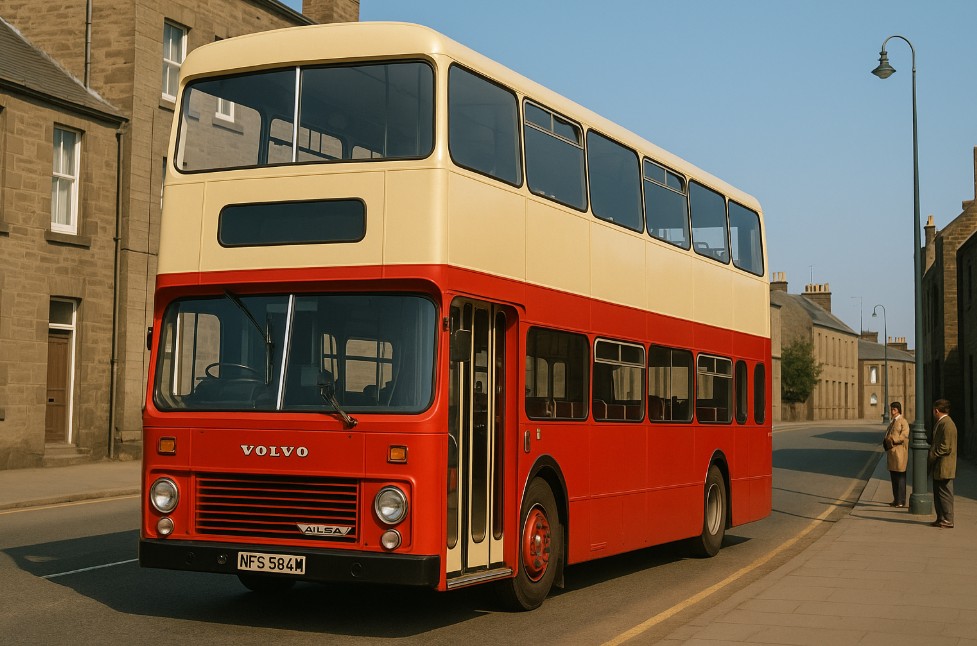Volvo Ailsa: The Scottish Powerhouse That Redefined Double-Decker Buses

When one speaks of iconic double-decker buses in the UK, the mind often drifts to London Routemasters or Alexander Dennis models. However, an often-underappreciated yet revolutionary entrant in the industry was the Volvo Ailsa. Produced between 1974 and 1985, the Volvo Ailsa B55 stood out as a uniquely front-engined, double-decker chassis that not only captured the essence of British transport innovation but also introduced practical benefits for urban transit authorities.
Origins and Development
The story of the Volvo Ailsa begins in the early 1970s, a period when many British transport authorities were seeking alternatives to rear-engined buses due to operational inefficiencies. Recognising this gap, Volvo acquired a significant stake in Ailsa Trucks Ltd and established Ailsa Bus Ltd in Irvine, North Ayrshire, Scotland, specifically to penetrate the British market.
From the start, the aim was clear: to develop a bus that offered the benefits of front-engine design (like easier maintenance and better weight distribution) while maintaining the passenger-friendly front entrance that had become a necessity in post-war British cities.
The Volvo Ailsa B55 Design and Engineering
The Volvo Ailsa B55 made its public debut at the 1973 Scottish Motor Show. It was built with a unique layout that allowed a front-engine chassis without compromising on the front entrance. This feature was particularly attractive for one-person-operated (OPO) services, which were becoming the norm in cities across the UK.
The chassis used the Volvo TD70 engine, a robust 6.7-litre turbocharged diesel unit, known for its longevity and fuel efficiency. Early models featured a Self-Changing Gears (SCG) semi-automatic transmission. Later variants, particularly the Mk II and Mk III models, transitioned to the smoother Voith automatic gearboxes, aligning more with evolving operator preferences.
Production Models: Mk I, Mk II, and Mk III
Over its eleven-year production run, the Volvo Ailsa evolved through several iterations:
Mk I (1974-1977)
The earliest version of the Ailsa was widely adopted by smaller operators, eager for a cost-effective, reliable double-decker. It set the groundwork for the Ailsa’s unique identity: practical, efficient, and adaptable.
Mk II (1978-1980)
This model introduced refinements in chassis layout and improved braking systems. There were adjustments to engine mountings and better access for maintenance, crucial for keeping downtime minimal.
Mk III (1980-1985)
The final version, the Mk III, was the most sophisticated of the range. It featured a revised rear axle sourced from Volvo’s F10 truck series, and for the first time, operators could opt for air suspension. These buses were also branded more prominently as Volvo products, moving away from the Ailsa-only identity.
Bodywork and Variations
Though the chassis came from Volvo, the bodywork was typically constructed by UK coachbuilders. The most common of these was Walter Alexander, whose dual-door configuration became synonymous with the Ailsa. Other notable coachbuilders included East Lancashire Coachbuilders, Northern Counties, and Marshall Bus.
There were even some exotic variations: three-axle export versions for Hong Kong and Indonesia, including air-conditioned units—a rare luxury at the time. These showed how flexible the Ailsa platform could be in meeting diverse market needs.
Adoption Across the UK
The Volvo Ailsa became especially popular with the Scottish Bus Group (SBG), which embraced it as a backbone of regional transportation. Operators such as:
- Tayside Regional Council ran over 160 Ailsas,
- Fife Scottish took delivery of 74,
- Eastern Scottish acquired over 80, including second-hand units,
- Strathclyde Buses also employed a significant number.
Further south, other Passenger Transport Executives (PTEs) such as West Midlands, South Yorkshire, and Merseyside adopted the Ailsa. Even London Transport conducted trials with three Mk III units in 1984, although they opted against large-scale orders.
International Impact
Although the Volvo Ailsa was primarily a British product, it found limited success overseas. One of its biggest international markets was Indonesia, where nearly 400 units were delivered for Jakarta’s urban transit.
China Motor Bus in Hong Kong also acquired a handful of Ailsas, although they suffered unfortunate setbacks such as fire damage and operational mismatches. Nevertheless, the mere presence of British-style double-deckers in Asia hinted at Volvo’s aspirations to globalise the Ailsa design.
Strengths and Weaknesses
Strengths
- Robust Front Engine Design: Easier to maintain and well-suited to urban driving conditions.
- OPO Capability: Aligned perfectly with the UK’s push for operational efficiency.
- Fuel Efficiency: The Volvo TD70 engine was frugal compared to other contemporary power units.
- Operator Flexibility: Multiple bodywork options allowed for high customisation.
Weaknesses
- Cabin Ventilation Issues: Some drivers reported poor airflow, especially in early models.
- Noise: Being front-engined, engine noise and heat transfer into the cab were common complaints.
- Limited Export Success: Outside the UK and a few Asian markets, the model didn’t attract substantial foreign orders.
The Volvo Ailsa in Urban Memory
In cities like Dundee, the Volvo Ailsa became more than just a mode of transport—it was a visual symbol of urban life during the late 70s and early 80s. Its unique engine hum, body styling, and colour schemes made it instantly recognisable. For many children growing up during this era, catching the upper deck of an Ailsa bus was a memorable part of daily life.
Photographs and models of the Ailsa are still cherished by transport enthusiasts, and several units have even been preserved by bus museums and heritage operators.
Transition and Replacement
By the mid-1980s, the Ailsa design began to feel dated. Newer technologies, changing regulations, and a shift towards rear and mid-engined models paved the way for its successor: the Volvo B10M Citybus. The B10M was more aligned with continental European trends and gained better traction in export markets.
Despite this, the legacy of the Ailsa lived on. Its practical design principles and focus on operational efficiency influenced later Volvo bus projects.
Legacy and Enthusiast Following
Today, the Volvo Ailsa enjoys cult status among UK bus historians and enthusiasts. Restored models occasionally make appearances at transport rallies and events. Publications, including dedicated books and documentaries, continue to explore its mechanical and cultural significance.
Moreover, transport authorities still regard it as a case study in balancing engineering innovation with operational needs. It was never the flashiest bus, but it was often the most dependable one in the fleet.
Conclusion
The Volvo Ailsa may never have reached the global fame of other Volvo bus models, but its contribution to British public transport is undeniable. As a Scottish-built solution to a very British problem, it delivered nearly everything operators asked for: reliability, efficiency, and adaptability. While its time on the streets may be over, its place in the history of urban transport remains secure.
From its thoughtful engineering to its legacy in the hearts of passengers and drivers alike, the Volvo Ailsa B55 stands as a proud testament to a golden era of public transportation in the United Kingdom.



